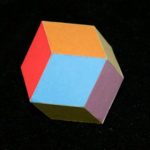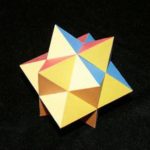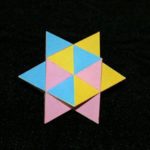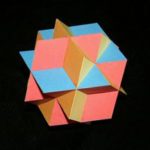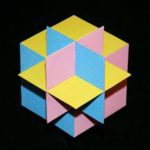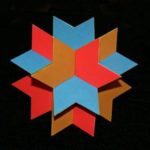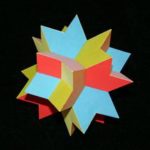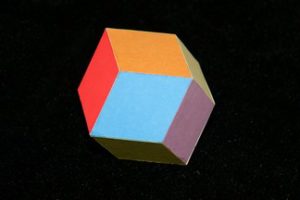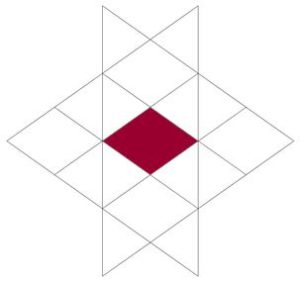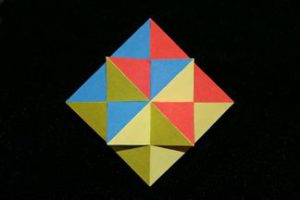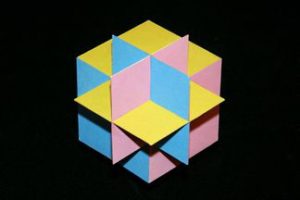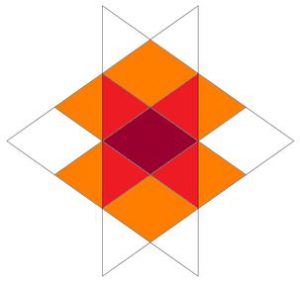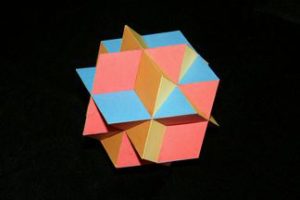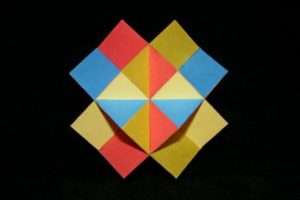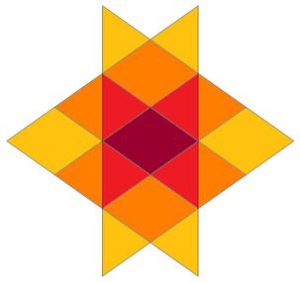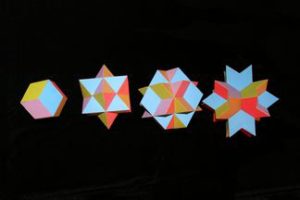We’ve had a brief look at the Stellations of the Archimedean solids, but there’s a hugely more challenging task awaiting when we consider the Duals of the Archimedean Solids: the Catalan Polyhedra. Even the thirteen basic Catalans themselves are quite odd-looking, and their stellated forms are a good deal stranger still – essentially because they derive from a huge number of faces intersecting at some really crunchy angles.
Back in 1989, Wenninger offered a comment in Dual Polyhedrons that few of these shapes had yet been studied or counted, let alone constructed. He looked forward to ‘computer analysis’ opening the topic up, but it’s not clear that anyone has actually explored much of it. Surfing the web in 2012 I found George Hart and the Great Stella software had something to offer, but there was still very little. We’ll begin, then, with the Rhombic Dodecahedron, which Cundy & Rollett discussed back in 1951.
The Rhombic Dodecahedron is an interesting shape in all sorts of ways: it has precisely twice the volume of a cube; you can tessellate the whole of space with only rhombic dodecahedrons; you can make each stellation with only one kind of ‘cell’; since it’s got 12 faces you also can make it up as a calendar; and you can make it quite easily an Origami model with A4 paper. But these are topics for another day! Our interest is that it’s the dual of a Cuboctahedron, and it turns out to have only few stellations – essentially three, plus a fourth if you include a ‘stellation to infinity’.
We start, as usual, with the basic shape and its stellation diagram:
To get the 1st Stellation we look at which cells in the diagram fall just next to the filled-in rhombus, and we build a shape out of those:
One of the curiosities of the Rhombic Dodecahedron is that it has rather a lot of axes of symmetry, which give a richly varied set of views of the model. This richness continues into the stellated forms: here are two specially-lined-up views of the same model…
For the second stellation we again move out to the next set of cells:
The third and last Stellation is derived in just the same way, and produces a beautiful shape reminiscent of horns or spikes or…well, something anyway.
In the next photo, you can see how the blue face grows and develops through the stellations: and in each one you can make out the “shadow” of the previous one:
And that’s it for the Rhombic Dodecahedron…unless…oh yes, we could do an “infinite” one, since there are lots of parallel lines in the stellation pattern. But that’s a topic for another day.
If you’ve stuck with me so far, well done. Following Cundy & Rollett the next topic is Stellations of the Triacontahedron, though I approach this with fear – there are vast numbers of potential stellations for this monster. There are, however, three which are extremely well worth a look, so here we go to Stellations of the Rhombic Triacontahedron.
